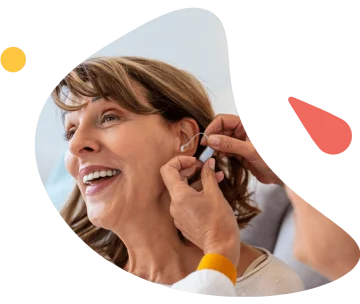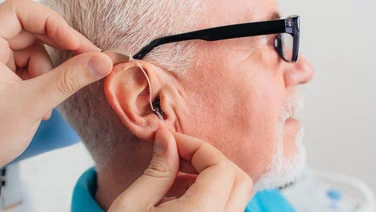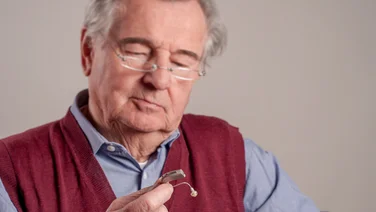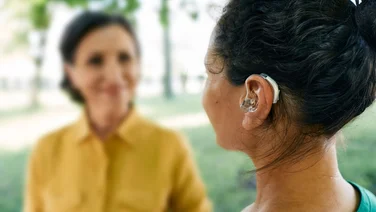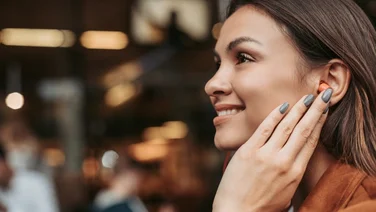Hearing aids are usually the best treatment for hearing loss, but they may not provide the same sound quality that a hearing person will experiences.
Bluetooth hearing aids can work alongside TVs, phones, and other electronic devices to improve the audio and enable you to hear the device more clearly and dynamically.
What are Bluetooth hearing aids?
Bluetooth is a technology that connects electronic devices without the need for wires. This enables you to share data and files, like documents, photographs, or videos, between them.
Bluetooth allows you to connect your hearing aids to a device that plays sound – like your phone, television, or music player – so you can hear the output more clearly.

These days, many electronic devices, including TVs, smartphones, computers, music players, and headphones have Bluetooth technology built into them.
If you wear a Bluetooth hearing aid, you can pair it with ones of these devices and the sound from that device will play directly through your hearing aid.
Do you need advice on bluetooth hearing aids?
How do I connect Bluetooth hearing aids to my device?
Connecting hearing aids to other electronic devices is fairly straightforward. You can either pair your Bluetooth hearing aids with the device directly, or use a streamer.
Bluetooth hearing aids and smartphones
How you connect your hearing aids with your smartphone will depend on the phone’s operating system – this is what lets you use the internet, apps, and other programs on your phone.
The two most widely used operating systems are Apple’s iOS, which runs on iPhones, and Google’s Android, which runs on other smartphones.
iPhone and hearing aids
Apple, which makes the iPhone, has developed its own Bluetooth connectivity, so certain hearing aid makes and models can link up directly with iPhones without draining the batteries.
Hearing aids that use the Apple-designed Bluetooth function are marketed with the ‘Made for iPhone’ feature.
Android and hearing aids
Google has also created technology that makes Android devices compatible with certain hearing aids. This is called the ‘Made for Android’ feature.
It is a relatively new development, so its only available on Android operating systems that are version 10.0, or higher.
Streamers
A streamer – a gadget like a small remote control, which you can wear around your neck – is a third device that acts as a technological go-between, enabling your hearing aids to communicate with your device.
Streamers are useful if your hearing aids or the device you want to connect to doesn’t have Bluetooth.
You pair the hearing aids with the streamer, and pair the streamer with the other electronic device, such as your TV. In this instance, the audio signal from the television will be sent directly to your hearing aid.
Many older Android smartphones need a streamer to link a phone to hearing aids.
What are the advantages of Bluetooth hearing aids?
There are numerous benefits to owning hearing aids with built-in Bluetooth. The most obvious of these is that they will help you to hear more clearly in several different situations. Other advantages include:
You can talk and listen, hands-free
When your hearing aid is paired with your smartphone, you can have a conversation without holding the phone to your ear.
As long as the paired hearing aid and smartphone are in range, you’ll hear the person’s voice directly through your hearing aid rather than the telephone receiver.
This will make communicating easier if you struggle to communicate over the phone, and it’s also handy when you’re doing something you need your hands for, like gardening or driving.
You can hear TV shows and movies at a comfortable volume
If you have a Bluetooth-enabled TV, you can stream the audio straight through your hearing aids, and adjust the sound quality and volume to suit you.
This is particularly useful if you enjoy watching TV with other people. You’ll no longer need to find the difficult balance between having the volume high enough that you can hear it, but not so loud that it’s uncomfortable for those around you.
Your hearing aids are your own personal headphones
If you like listening to music or podcasts, you can stream them from your smartphone or music player directly to a Bluetooth hearing aid.
This could be a real advantage if you’d rather keep your listening preferences private, or if you’re in a public place. Your hearing aids act just like wireless headphones, so you won’t disturb those around you.
You can participate more easily in video meetings

Whether you work from home and need to have online video meetings with colleagues, or you want to video chat with family members overseas, pairing your hearing aids with your PC, tablet, or smartphone can enable you to participate more easily.
Do you need advice on bluetooth hearing aids?
What else do I need to know about Bluetooth hearing aids?
Bluetooth connectivity and the ability to link with streamers are a common functionality of many hearing aids, but not all hearing aids have these features.
In addition, not all types of hearing aids can work with Bluetooth, so if it’s something you need make sure to ask your hearing aid provider.
It is also worth noting that Bluetooth can also drain your hearing aid batteries quickly, so it’s worth weighing up the cost of replacement batteries and how often you’ll need to replace them when choosing your hearing aids.
Hearing aids with Bluetooth are also generally more expensive than those that don’t have Bluetooth. But as the technology becomes widespread, more hearing aid manufacturers are incorporating it as standard into their products.
As a result, the price difference between Bluetooth-enabled hearing aids and others is narrowing.
However, if you’re buying new hearing aids and you want to use them with your electronic devices, make sure you know what other equipment or accessories you might need.
As with any hearing aid, it’s a good idea to shop around to find the best hearing aid options for you.
